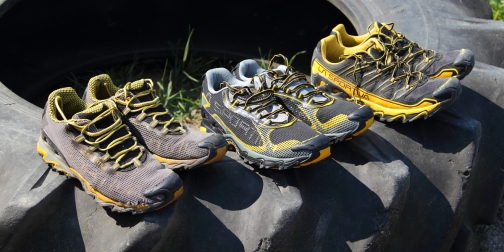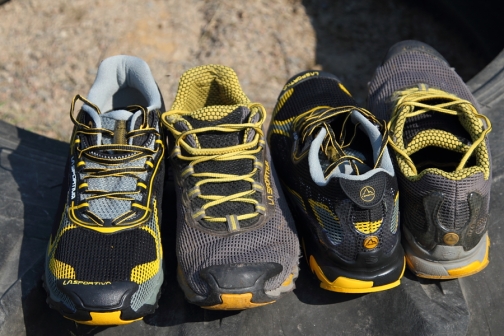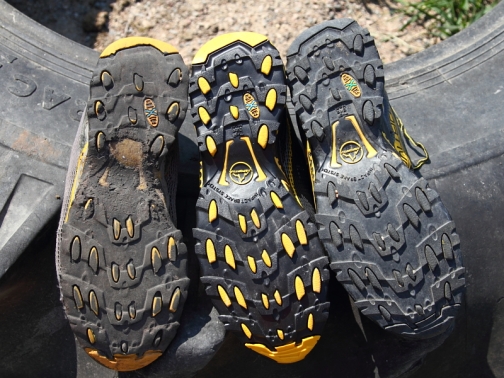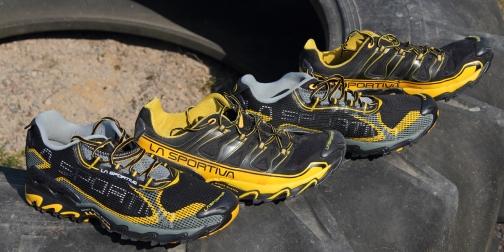The title states the obvious facts about last Wednesday’s micro adventure I did with classmates from the wilderness guide school but apparently there is more to say about the trip than the numbers as this turned out to be quite a long post.
The Niittylahden opisto has also many other courses and classes than the wilderness guide course so occasionally the schedules include things like a fire drill and lectures about dangers of drugs. And for some reason this didn’t appeal too much to our class of guide students so instead, we decided to take a long walk that day. I had planned walking the Herajärven kierros trail in one day for some time and the last Wednesday seemed to be a good day for that. It was easy to talk the classmates to come along and so at 0700 am we hopped into our cars and drove towards the Koli National Park and the Herajärven kierros.
The Herajärven kierros trail
The Herajärven kierros is a 40 kilometer long circular trail that circumnavigates the Herajärvi lake and visits the high hills of Koli. Because of the hilly terrain the total elevation gain of the trail is over 1000 meters. The annual Marathon of Dangers follows about the same trail but with the few extra kilometers collets a total elevation gain of 1150 meters. The trail is well-marked and can be walked even without a map btu you can buy good maps from the visitor center for 5 euros. There are also lots of services along the trail. For example a teepee style shelter at Ryläys, the hotel with all modern luxuries at Koli, simple bead & breakfast accommodation at the Kiviniemen tila farm, some fireplaces with firewood, etc. This July the trail was extended with a 20km loop to the South forming now a figure eight style trail. We walked only the traditional 40km loop. Maybe I’ll do all the 60km next spring…
The walk

Getting ready at the Kiviniemi parking area.
Two of us wanted to walk only a half of the trail so we gave them a ride to the hotel and visitor center at Koli in the Northern end of the loop and then the seven of us drove to the Southern starting point of Kiviniemen tila farm. We donned our relatively light backpacks and left the parking area around 09:40 am walking the trail in clockwise direction i.e. starting on the Western side. The weather was cloudy but otherwise very nice: not too warm, not too cold, a bit moist air.

The views along the trail.
We planned to have a five-minute break each hour but after the first two hours and te two short breaks we forgot this routine and had short (less than five minutes) breaks when ever necessary, like when adjusting gear or admiring the views as the weather was getting better all the time. After the first 10km or so we had a bit longer break, maybe around ten minutes, at the shelter in Ryläys. The going was good and all were in a good mood. There was a spring to fill up our water reserves after the shelter but it was claimed as undrinkable because of E. coli bacteria. Well, no surprice that there is coli at Koli… It was a bit of a disappointment as I had only two liters of water with me but I still had some half a liter left so instead of boiling the water, we continued forward.

The views were not too bad.
We met the two girls soon after the spring and they told that there was water available at Ikolanaho a few kilometers away. So we continued once again. At Ikolanaho we found a spring and again warnings about E. coli bacteria and the need to boil the water before drinking. Bugger! (Later on we found out that there was also a well with drinkable water.) We sat on the grass, played a bit a frisbee and ate some snacks without water to drink. One of our fellowship of seven announced that he had already been at Koli before and wasn’t interested to walk the hilly three kilometers there and then back again so he continued alone to warm up the open sauna at Kiviniemi for the rest of us.

Decisions, decisions... To go to Koli or to have some free time? 😉
We, the remaining six, walked and occasionally run abit to check the views from each of the hill tops of Koli and then hit the hotel restaurant for some coffee, pastries and beer. We did it somewhat the wrong way as we first had coffee withsweet pastries and then went outside to the front lawn with our stoves and freeze-dried meals… It was nice to lay on the lawn in the sun and wait for the food. Some of us, me included, changed into dry socks. I think that if I’d walked the rest of the trail in wet socks I might have gotten some blisters so it was a good choise. We had nearly one and half hours pause at the hotel, our halfway point, but then it was time to go on again. A slight haste was the most typical feature of this trip…

Enjoying the views at the top of Paha Koli. Occasionally the haste was forgotten.
For me the climb up to the hill Mäkrävaara was maybe the hardest part of the trail but we all were still in good mood enjoying the great views and the nice trail so no real problem there. After Mäkrävaara we had only two shorter breaks but otherwise just kept walking. When the clock was closing to 0900 pm it started to become dark and for the last 45 minutes or so we walked in darkness with the occasional help of headlamps. The trail was mostly easy to walk even in the dark so we were able to keep up our pace.

Having a road side picnic at the Zone.
The last thing before Kiviniemen tila was a water crossing with a rope pulley ferry that barely could float all the six of us and despite hitting some rocks before getting to the opposite shore we got across with dry feet. From the ferry it was only a few minutes walk back to our cars clock telling that we made the walk in a bit under 12 hours! The time was way better than I had anticipated, especially with some longer breaks, and to my surprise no one of us had any problems during the long and somewhat demanding trail. I got a minor blister to my right heel because my trail runners are starting to be really worn out, one of us got some chafing to her lower back from her rucksack and the one us who was testing his brand new hell-of-a-heavy-weight Meindl Army Pro boots got a bit sore ankles but that was about it.

Sun setting.
From the cars we walked to sauna, had a wonderful but quick sauna and a dip in the Herajärvi that we had just circumnavigated and then head back to school as the next day was a typical school day: starting with breakfast at 0745 am and lectures at 0830 am. After six hours sleep the morning sun saw us walking for our daily morning swim with stiff feet but smiles on our faces. It was a good test for the school’s 24 hours walking challenge and for speedier future hikes.
The gear
Luckily it wasn’t raining as I had forgotten my shell jacket and fleece shirt at home on the previous weekend and didn’t take those with me… But I had a punch of other stuff, some useful and some redundant. All the gear and food I had with me is visible in the picture below.

From the left: the stuff I was wearing, spare clothing, minor essentials, food, drysack, runners, water bottles and the backpack.
I walked in my old and beaten La Sportiva Wildcats. These have now an outer soles cracked in half, a lot of holes in the outer and very worn lining (or actually, non left) in the heel area but still they perform very well so I have a new pair coming up. I had two pairs of Inov8 Prosocks and in the half way I changed my wet socks to dry ones as the trail was getting more dry during the day. The socks worked well. (Earlier this summer I had two pairs of Inov8 Elite Sock both lasting less than 50km before wearing out!) I had also Inov8 Debris gaiters to keep all the little squirrels and other stuff out of my shoes. Very nice piece of kit. For clothing I had Haglöfs Intense tights with thigh pockets and intense zip top shirt. Both worked very well and are, in my opinion, very well suited for this sort of active use. For headwear I had a Haglöfs Box cap but maybe a lighter Buff would have been better in this case. And I also had my knee braces, visible in the picture at the left, which were probably crucial. I planned also to use poles to save my knees but forgot those in the car and managed well without.
On my back I had an Osprey Talon 33 pack which is otherwise nice but the compression system interferes badly with the water bottle pockets making it a pain to use them. And as I prefer bottles I had two one liter bottles with me the other one being unnecessary heavy Nalgene bottle. For extra warmth I had a Montane Featherlight pants, a Finnsvala merino shirt and a Marmot down vest though I would have managed as well without them. The spare socks came handy as mentioned. I had also a small towel to dry my feet but I could have gone without as well. Inside the pack I had some small essentials, quite a comprehensive first aid kit as a shared piece of gear (I had that one and my friend has a Jetboil Sol stove for us), headlamp and big pile of food. All was packed in a light roll top bag in case of rain. As a camera I had a Canon S90 point and shoot. It is light weight but can take reasonably good quality pictures in raw format. An easy choise instead of a waterproof Olympus producing lousy pictures or the EOS 550D DSLR which is very nice camera but hell of a heavy weight for trips like this.
I had too much food. I came to this conclusion already before leaving but didn’t bother doing anything about it. After the walk I still had two chocolate bars (á 52g), two flapjacks (á 145g), a bag of peanuts (100g) and two cups of hot chocolate (á 23g). This means that I had over half a kilo of extra food. The amount of food might have been okay if I would have overnighted and continued walking again the next morning but now that I got back to school after the walk, there was no need for that much food. This was good to know for future trips. Other than amount-wise the food was good. Snickers style chocolate bars work like a charm, honey roasted peanuts are super good, small salamis go as salty snacks and the MX3 Vegetable pasta was a nice hot meal at the half way. Though if I wouldn’t have been sharing gear I would have skipped the hot meal and eaten a flapjack instead.
So, that was it. A good walk with promising results regarding future walks and the 24 hour challenge in mid October. The gear worked as predicted but I had too much of it and too much food too. More walks to come. 🙂
Jaakko Heikka - Professional wilderness guide and diehard outdoor enthusiast with a special interest for lightweight backpacking, arctic expeditions and outdoor photography.























